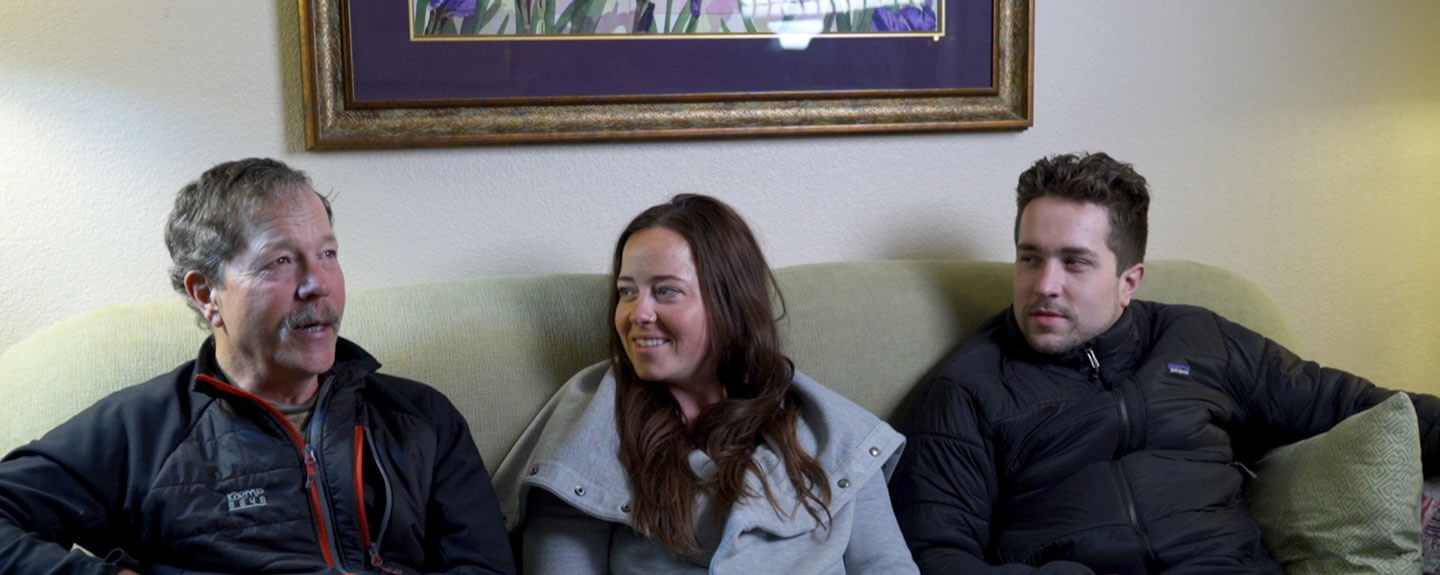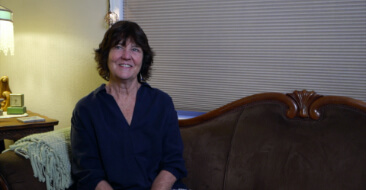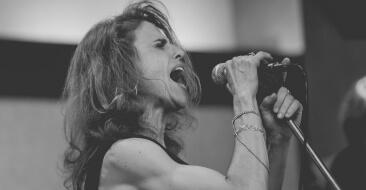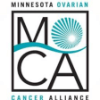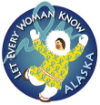Craig Ely is sitting on the couch at his home in Anchorage, Alaska, with his daughter, Tessa, and son, Colin. The retired wildlife research biologist is the husband of ovarian cancer survivor Mary Rita Ely, and his family has been through a lot in recent years.
“Ovarian cancer is very unrepresented in the media,” he starts. “Everyone knows about breast cancer. Heck, even football players wear pink jerseys on the field. Ovarian cancer is just not as common. But everyone knows someone who has ovarian cancer and it’s rare for them to survive. It’s like the Vietnam War versus World War II. It just doesn’t have the public support. Breast cancer is on everybody’s lips. Other cancers aren’t.”
Ovarian cancer is the fifth leading cause of cancer deaths among women, deadlier than any other female reproductive cancer. Unlike breast cancer, there are currently no screening tests for the early detection of ovarian cancer. Typically, by the time ovarian cancer symptoms become obvious and a woman is diagnosed, her cancer is already in stage III or stage IV. Despite these facts, ovarian cancer has not received much attention in the mainstream media. This reality makes an already challenging disease only harder for the people who go through it, as well as their families.
Tessa recalls feeling socially isolated. “I had a friend whose mom had breast cancer,” she says. “I was like, ‘She kind of understands.’ But when her mom went into remission, well, remission just doesn’t exist for our family. With ovarian cancer, there’s never a sense of, ‘We’re done with that, let’s move on.’ We wish it could be that way, but it keeps us on our toes.” Colin also felt misunderstood by his peers. “I talked to my best friend and my brother, but I really didn’t know anyone who was going through anything similar,” he says.
The Ely family is speaking out about their experience in the hope that their story will help other families find support. “Be aware, be supportive, and pay attention,” Craig says. “People who don’t have cancer should be more aware of the people around them and listen.” They also hope that their story will encourage people to listen to the women around them, and to play an active role in the early detection of ovarian cancer. “It’s not just on women to know what’s going on with their bodies, but it’s on their partners, their brothers, everybody,” Tessa says, “So often, women are others-oriented and so busy taking care of others that they don’t take care of themselves. Listen to the signs. Slow down enough to listen to them.”
Their cancer story began in August of 2006. “I remember getting the phone call from Mary Rita,” Craig says, “She said, ’You need to take the kids over to our friend’s, Mike and Lesley’s. I’ve got something to share.’ I could tell that it wasn’t going to be good news. How bad the news was, that was the question. I didn’t know much about ovarian cancer; I just knew that cancer wasn’t good. I had been out in the field during her visits to the doctor, so I didn’t get to see the progression. It was out of left field for me because I had been concentrating on my work.” Mary Rita was just as shocked by her diagnosis.
“I remember going up to a family friend’s house for a while, while Dad went to the doctor,” Tessa fills in a gap. She pauses, and points across the room. “I remember sitting on that couch when my mom told me. The rest was kind of a blur. I remember being in my room and having a hard time. I remember Mom coming down and just laying in my bed,” she says. She was one week away from leaving for her freshman year of college on the East Coast. “I knew right away that there was no way I was going to leave for college. I was packed and ready to go, but there was no question in my mind.”
Colin, who is much younger, was about to start seventh grade. “I don’t remember much from that day; I was so young and it was so long ago. The following months, though, were just a lot of anger and confusion. Especially around that age group, it’s really hard to process something like that, when you don’t know if your mom is going to be alive anymore.”
Their lives changed overnight. “There was less conversation and more experience,” Tessa says, “We didn’t feel like there was a lot of room for conversations about this stuff, more just being at the hospital. I remember thinking, ‘Okay wow, times are changing. I’m wiping my mom’s a** way sooner than I thought I would.’ I thought she would be at least 75,” she laughs. “She’s the strongest person any of us have ever met. To have the strongest person you know need your help as a kid is hard. I found a lot of strength in trying to be supportive for my brothers. They were trying to chug along in school. Mom tried, and did a great job, of keeping things as normal as possible.”
Everyone in the family experienced a drastic shift in priorities.
“I remember my friends telling me stories,” Tessa says. “I would think to myself, ‘I could give a f***, none of this matters.’ When I talked to Mom, I would just check in, ‘Do you care about this, or not?’ I was just checking in but of course, she’s a mom, she wants to know all the little details. She shaped the people she surrounded herself with, who she spent time with. We didn’t have time for people who couldn’t get real and be present in the moment and soak up life and connect and live heart-first. We’ve had a richer and fuller life since Mom got sick than people who don’t realize it until they’re on their death beds. Since she has been around, it has been a huge gift. She’ll say, ‘I’m sorry you guys have to go through this,’ but when it comes back, and hopefully it won’t, it gives us refreshers of what’s important. Our lives are so much richer with her in them.”
Meanwhile, Colin had to grow up faster than his peers. “During seventh and eighth grade, I didn’t do so much, but after freshman year – over high school – there were more important things going on than the daily,” Colin says. “It matured me. When I got to certain stages in life, I was already ready for the next step. I went to school in California. I went for adaptive P.E., which is physical education for people with special needs. I felt like I already had so much experience that I wanted to start my career. In middle school, it was such a shock that all my other stuff didn’t matter so much, I just needed to spend time with my mom. I didn’t know how much time I had with her.”
Mary Rita has been through five rounds of ovarian cancer. When she got her second round, Colin was a high school junior. “I didn’t care about other people who were going out drinking and partying, I would rather spend a night watching a movie with my parents,” he says. “Lots of my friends were mature for their age too. I prioritized just hanging out and spending time with my best friends and my parents more than going out and drinking. It mattered more to spend more time with the people who matter and who you really care about. You have to cherish the time you have with each other.”
Craig says it’s helped him realize the importance of every day, every week, and every month. “If she’s doing well on a new drug, and we need those to keep being developed, she takes a blood test every month or so to find out how she’s doing.” He tears up. “It’s got to be tough for her. She’s pretty tough to protect, it would be like protecting a sow grizzly bear, but even with that personality, you need to be aware there’s stuff going on that she’s not sharing.”
Although they didn’t have many peers, the Ely family did not have a lack of support. After Mary Rita was diagnosed, they received a flood of help from their friends and family. “We were lucky to have lots of good friends to support us,” Colin says. “I had my dad, my sister, my brother, and a really good friend. I went over to his house to hang out a lot. They were an integral part of helping us get through it.”
“We all took after our mom,” Tessa adds. “‘Get your sh** together, we’ve got some stuff to do, we’re going through the motions and we’re supporting each other.’” Mary Rita is an incredibly strong woman who was also able to be there for her family in the midst of battling cancer. “She was very even-keeled and in control of the situation,” Craig says. “She was always thinking about what was going to be best.”
It helped them deal with the feelings of isolation. “All my best friends left for college,” Tessa says. “It was kinda just me. That was hard, but we had really great family support and a great family friend support network. We just powered through. I had a great educational experience in ‘all the ways.’ I learned a lot more being with my family than I ever would have going to the East Coast. I’m really glad I was able to stay.”
“I’m just glad we got through it the way we did and I think we grew as a family,” Colin says. “Our relationships and bonds got a lot deeper. Luckily, I was able to go down with her for some treatment—everyone was. That made a big difference. I think that especially when you’re that young, it can be really confusing and hard to process. It can be hard for your parents to know how much to tell you—to give you enough details so that you can process it, but not to scare you. A big thing is knowing that there are resources out there. Finding a support group is important. I was in seventh grade. Being in middle school in itself is pretty tough. Our family friends brought meals and watched us while my mom and my sister were gone.”
These days, every member of the Ely family is vocal about ovarian cancer. They were involved in helping start Let Every Woman Know, an Alaska non-profit that raises awareness for gynecologic cancers like ovarian cancer. “We had a lot of friends who wanted to support but didn’t know how. It gives them an event to show up at and a way to help spread awareness,” Tessa says. “Not a lot of people whose mom has gone through her 5th bout of cancer have been able to say that she’s still alive,” Colin adds.
A big part of the Ely family’s community support comes through the advice they can share as a result of their experience. “Mom didn’t know in April, four months before her diagnosis,” Colin says. “She felt a small pain in her side that most people would write off, some physicians even, but if you catch it earlier, there’s a better chance they may be able to eradicate it. Take everything seriously. Even the smallest thing can be a bigger problem—can compound to become bigger and bigger. It costs so much to get treatment, but you can’t put a price value on someone’s life.”
“A big thing for us was going to counseling,” Craig says. “We said, ‘We’re going to go out and talk about this.’ Kids especially don’t have a chance to communicate what’s going on – something that may pop up ten years later as a big anger thing. Mary Rita was very progressive to do that. It was a helpful thing that we got together and said, ‘This is a family issue and we need to address it.’”
“I might add, women with cancer can feel like they’re a burden,” Colin says. “Whether you get a family counselor or you go by yourself, get that stuff off your chest. The healthier you are, both physically and mentally, the stronger you are and the more able you are going to be to defeat this disease—to combat it. Mental illness often takes a back seat to physical illness. It needs to be spoken about today. Mom seems very centered now, but she didn’t used to be. Having high school kids is not easy, even if you don’t have cancer. Having someone to decompress makes a big difference.”
“Mom sought alternative healing as well,” Tessa says. “She saw a naturopath and she got acupuncture and massage in both Anchorage and Seattle. This was huge for mitigating the side effects of chemo. Most people who get IP (the kind of chemotherapy Mary Rita received) were unable to complete more than a handful of rounds. She chugged along and she was rarely nauseous. The holistic approach was really helpful, joining eastern and western medicine. It really improved her quality of life throughout the healing process.”
“Her brother is a naturopath in California,” Colin says. “He offered suggestions on supplements that would be helpful. He always wants to see her bloodwork. He uses her as an example of how important a positive attitude, complementary medicine, and being proactive in your health care is when talking with patients. Naturopaths and Western medicine often butt heads, but he’s an advocate for treating the whole patient with the best options available. Some people are one or the other, but the combination of both is the best chance of beating cancer and of improving your everyday lifestyle.”
Craig shares one final piece of advice: every family’s journey through ovarian cancer is different.
“I think it’s going to depend on the patient and the women’s situation. Mary Rita is very strong and strong-willed. She had a network of people she could reach out to and she got support from a lot of different places, but it is important to pay attention to where the weak spots are. For me, it was a lot of doing the research on what’s the best treatment. It wasn’t black and white and there was a lot up in the air. I talked to my brother who is an MD, my dad, and my sister who is a PA, and they advised us on the procedure. It’s good to bring friends in. That’s the main thing. Use every resource.”
